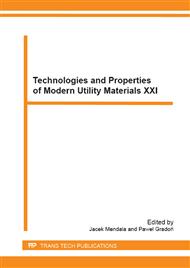[1]
Y. Tamarin, Protective coatings for turbine blades, ASM International, The Materials Information Society, Materials Park, Ohio, (2002).
Google Scholar
[2]
A.K. Koul, V.R. Parameswaran, J-P. Immarigeon, W. Wallace, Advances in High Temperature Structural Materials and Protective Coatings, A Publication from National Research Council of Canada, Ottawa, (1994).
Google Scholar
[3]
Seon-gab Kim, Young-ha Hwang, Tae-gu Kim, Chang-min Shu, Failure analysis of J85 engine turbine blades, Engineering Failure Analysis 15 (2008) 394-400.
DOI: 10.1016/j.engfailanal.2007.01.015
Google Scholar
[4]
Haijun Tang, Dashu Cao, Hongyu Yao, Mingli Xie, Ruichun Duan, Fretting fatigue failure of an aero engine turbine blade, Engineering Failure Analysis 16 (2009) 2004-(2008).
DOI: 10.1016/j.engfailanal.2008.07.010
Google Scholar
[5]
A. Strang, E. Lang, R. Pichoir, Practical implications of the use of aluminide coatings for the corrosion protection of superalloys in gas turbines, Materials Substitution and Recycling, AGARD Conference Proceedings SMP 356 (1983).
Google Scholar
[6]
A. Strang, High Temperature Properties of Coated Superalloys, Behaviour of High Temperature Alloys in Aggressive Environmeents, The Metals Society, London, UK (1980) 595-611.
Google Scholar
[7]
M. Zielińska, J. Sieniawski, M. Wierzbińska, Effect of modification on microstructure and mechanical properties of cobalt casting superalloy, Archives of Metallurgy and Materials 53 (2008) 887-893.
Google Scholar
[8]
F. Binczyk, J. Śleziona, Effect of modification on the mechanical properties of IN-713C alloy, Archives of Foundry Engineering 10 (2010) 195-198.
Google Scholar
[9]
Y. Xiong, A. Yang, Y. Guo, W. Liu, L. Liu, Grain refinement of superalloys K3 and K4169 by the addition of rafineres, Science and Technology of Advenced Materials 2 (2001) 13-17.
DOI: 10.1016/s1468-6996(01)00019-5
Google Scholar
[10]
Y. Xiong, J. Du, X. Wie, A. Yang, L. Liu, Grain refinement of Superalloy IN 718C by the addition of Inoculants, Metallurgical and Materials Transactions 35A (2004) 2111-2114.
DOI: 10.1007/s11661-004-0159-8
Google Scholar
[11]
M. Cieśla, F. Binczyk, M. Mańka, Impact of surface and volume modification of nickel superalloys IN-713C and MAR-247 on high temperature creep resistance, Archives of Foundary Engineering 12 (2012) 17-24.
DOI: 10.2478/v10266-012-0101-2
Google Scholar
[12]
F. Binczyk, P. Gradoń, M. Mańka, Mechanical Properties And Creep Resistance of Nickel Alloys After Complex Modification And Double Filtration, Archives of Foundary Engineering 12 (2012) 5-8.
DOI: 10.2478/v10266-012-0026-9
Google Scholar
[13]
M. Cieśla, Durability of ŻS6U nickel superalloy with aluminide protective layer in thermal and mechanical load conditions, Monograph, Ed. Silesian University of Technology (in Polish), (2009).
Google Scholar
[14]
J. Okrajni, M. Cieśla, L. Swadźba, High-Temperature Low-Cycle Fatigue and Creep Behaviour of Nickel-Based Superalloys with Heat-Resistant Coatings. Fatigue and Fracture of Materials and Engineering Structures 21 (1998) 947-954.
DOI: 10.1046/j.1460-2695.1998.00090.x
Google Scholar
[15]
H.J. Frost, M.F. Ashby, Deformation-Mechanism Maps. The plasticity and creep of metals and ceramics, Ed. Pergamon press, Oxford, (1982).
Google Scholar
[16]
J. Wyrzykowski, E. Pleszakow, J. Sieniawski, Deformation and cracking of metals (in Polish), Ed. WNT, Warszawa, (1999).
Google Scholar
[17]
M.Ł. Bernsztejn, W.A. Zajmowskij, Structure and mechanical properties of metals (in Polish), Ed. WNT, Warszawa, (1973).
Google Scholar
[18]
F.R.N. Nabarro, C.M. Cress, P. Kotschy, Thermodynamic driving forse for rafting in superalloys, Acta materialia 44 (1996) 3189-3198.
DOI: 10.1016/1359-6454(95)00423-8
Google Scholar
[19]
A. Epishin, T. Link, Mechanism of high temperature creep of nickel-based superalloys under low applied stresses, Philosophical Magazine 84 (2004) 1979-(2000).
DOI: 10.1080/14786430410001663240
Google Scholar


